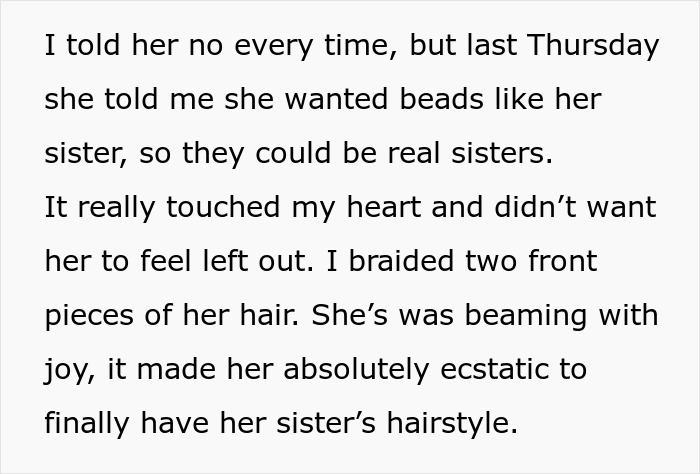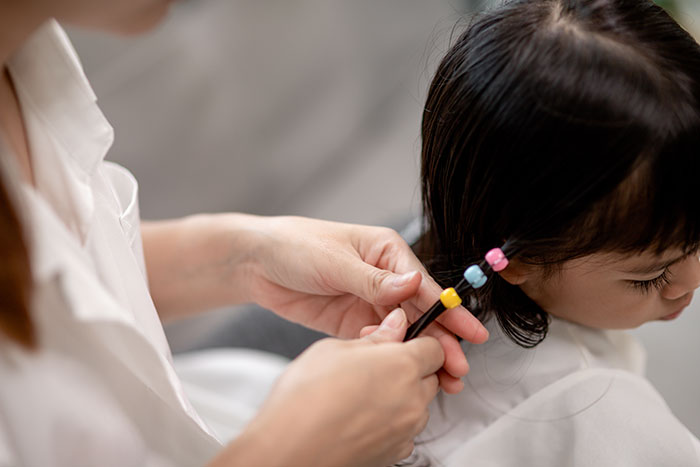It’s absolutely adorable when siblings are best friends. And when they admire one another and want to be just like their big brother or sister, it must melt their parents’ hearts. So when one 7-year-old begged her stepmother for the same hairstyle as her younger sister, it was almost impossible to say no.
But the mom later regretted innocently giving her stepdaughter braids after they became the catalyst for family drama. Below, you’ll find the full story that this woman recently posted on the “Am I the [Jerk]?” subreddit, as well as a conversation with Tamekia Swint, Founder and Executive Director of Styles 4 Kidz!
This woman’s white stepdaughter begged her for braids that would match her younger sister’s
Image credits:amyengelsman (not the actual photo)
But she soon regretted giving in after the girl’s mother was furious about the hairstyle
Image credits:dasha11 (not the actual photo)
Image credits:Throwawayll2h
Later, the stepmom responded to several readers and provided more information on the situation
“Allowing a sibling biologically connected to another sibling to experience the same hairstyle in a culturally appropriate way is a beautiful bonding experience”
To gain more insight into this topic, we reached out to Tamekia Swint, Founder and Executive Director of Styles 4 Kidz, a Chicago-based salon and organization that provides hair care services, support, and training for transracial families that are adopting or fostering Black children.
Tamekia was kind enough to have a chat with Bored Panda and explain the different needs that kids in multiracial families have. “Their family dynamics are different from those of a traditional family who are all the same race. Allowing a sibling biologically connected to another sibling to experience the same hairstyle in a culturally appropriate way is a beautiful bonding experience,” she explained.
“In this situation, I don’t think Mom did anything wrong except ask the biological parent whether it was okay to do the style in advance. However, in families with no biological connection, kids can be encouraged to choose culturally appropriate styles through regular conversations about the differences that exist between races,” Tamekia continued.
“We need more conversations about our cultural differences happening regularly – in school and at home. These conversations lead to cultural clarity, where children understand the differences and can embrace their own cultural identities. White and Black girls can both have braided hairstyles – worn differently.”
Image credits:FamilyStock (not the actual photo)
There are resources available online to teach white parents how to care for and style African hair
We were also curious why it’s often difficult for white parents to understand African hair. “It’s difficult because they need reference points,” Tamekia noted. “Straight hair is the norm in society, and its care is prioritized over what is needed for Black hair. If you have never had to comb or manage textured hair, you would not know. Caring for Black hair is not taught openly or widely – even in most Cosmetology programs.”
As far as how white parents can educate themselves on Black hair, Tamekia says that is exactly why she created Styles 4 Kidz. “To bridge the cultural gap for White parents who needed to understand these cultural hairstyles,” she explained. “When I started, there was a real educational desert for learning, and don’t get me wrong; these educational deserts still exist in remote areas.”
“However, over the years, more videos and resources are available online. In a simple Google search, the mom in this story could have learned how to remove beads and braids from her daughter’s hair,” Tamekia shared. “Also, Styles 4 Kidz has an online training platform specific to the hair care needs of multiracial families, particularly in adoption or foster care.”
Image credits:Christin Hume (not the actual photo)
“Equitable rights for African, Black, and textured hair are essential in every community”
When it comes to the most important things white parents should do when they have children with African hair, Tamekia says investing in education is crucial. “We study for anything else we want to do in life, so why would you not need to do that to learn about your child’s textured hair?” she asks. “Diversify your circle. Get to know people with textured hair and include them in your personal circles! Make this a part of your learning journey. Stay curious and open.”
“The need for textured hair education in libraries, hospitals, schools, and agencies- anywhere people are cared for – is a real problem,” Tamekia added. “Equitable rights for African, Black, and textured hair are essential in every community – worldwide, and we need more people willing to join the cause. If you are interested in being a part of the change that is coming, connect with us as we are raising up parent advocacy groups in every community to stand up and speak out for what is needed.”
We would love to hear your thoughts on this situation in the comments below, pandas. Do you think this mother did anything wrong by braiding her stepdaughter’s hair? Feel free to share, and then if you’re interested in checking out another Bored Panda article discussing drama between parents, look no further than right here!
Image credits:Alex Robinson (not the actual photo)
Readers assured the woman that she had done nothing wrong, while many noted that the haircut was not necessary
This post was originally published on this site be sure to check out more of their content.





















